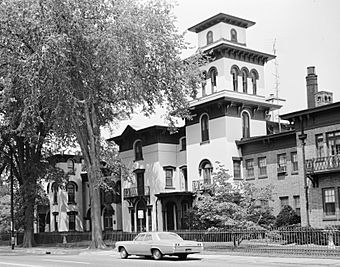Coltsville Historic District facts for kids
|
Coltsville Historic District
|
|

|
|
| Location | Hartford, Connecticut |
|---|---|
| Built | 1855 |
| Architectural style | Italianate |
| Website | Coltsville National Historical Park |
| NRHP reference No. | 66000802 |
Quick facts for kids Significant dates |
|
| Added to NRHP | November 13, 1966 |
| Designated NHLD | July 22, 2008 |
The Coltsville Historic District is a special historical area in Hartford, Connecticut. It's known as a National Historic Landmark District, which means it's a very important place in American history. This district includes the factory, homes for workers, and houses where the owners lived. All these places are connected to Samuel Colt, who was famous for making firearms and creating new ways to build things.
Coltsville is about 260 acres (105 hectares) big. It was once part of the Colt Industrial District, which was added to the National Register of Historic Places in 1976. In 2008, it became a National Historic Landmark. Later, in 2014, President Barack Obama signed a law to make it a National Historic Park. This new park works with the community to share its history.
Contents
Exploring the Coltsville District
The Coltsville District is a large area south of downtown Hartford. It is bordered by Wyllys and Charter Oak Avenues to the north. To the east, you'll find Van Dyke Avenue and the Connecticut River. Warwarme Avenue is to the south, and Wethersfield Avenue is to the west. This area includes the entire community that Samuel Colt planned around his factory. You can see Armsmear, which was his home, and homes for his workers. There are also community buildings like the Church of the Good Shepherd and Colt Park.
The Story of Coltsville
Samuel Colt, who invented the automatic revolver, had a huge impact on this area. In the 1840s, Colt bought a large piece of land and opened his first factory in 1848. He was inspired by a trip to London in 1851. Colt decided to build a special community for his workers right next to his factory, the Colt Armory.
By 1856, Coltsville was like a small city within Hartford. Workers from many different countries and religions lived and worked together. Colt's complex also had the largest armory in the world. It even had docks and ferry services on the Connecticut River.
Coltsville was one of America's first "company towns." It was very advanced for its time. Colt made sure his employees worked a ten-hour day. He also added washing stations in the factory and gave a one-hour lunch break. He built the Charter Oak Hall, where workers could relax, read newspapers, and play games. Colt ran his factory with strict rules. He would fire workers for being late or for doing poor work.
At the highest point of the complex was Armsmear. This was a huge Italian villa that Colt built for himself and his wife in 1857. It was probably the most luxurious house in Hartford at that time.
Colt's Innovations and Legacy
In 1864, a big fire destroyed the original armory. Colt's wife, Elizabeth, had the armory rebuilt. She made sure it included the famous blue onion dome with gold stars. This dome, topped by a gold orb and a horse, is still a symbol of the Colt Manufacturing Company. It stands as a reminder of Samuel Colt and the huge company he created.
Samuel Colt is famous for inventing the revolver. But he also changed how factories worked. He developed new methods for mass production, which means making many products quickly. His business ideas were also new. He used patents to protect his inventions and created new ways to market his products. This made his business very successful, even after he died in 1862. His wife, Elizabeth, continued to run his businesses for 40 years.
Colt hired Elisha K. Root as his main mechanic. Root helped set up the factory's machines. He created special tools and machines for Colt. Historians say Root was the first to build special machines for making commercial products. Thanks to Root, Colt's dream of mass production came true.
Colt's factory was one of the first to use the idea of an assembly line. This idea was not new, but it hadn't worked well before because parts weren't interchangeable. Root's machines changed this for Colt. The machines did most of the work, so only a small part needed hand-fitting. Colt's revolvers were made by machine, but he still wanted them to have a handmade feel. He hired skilled engravers from Bavaria to add beautiful designs to his guns. To attract more skilled workers from Europe, Colt built homes that looked like a village in Potsdam, Germany. He also planted willow trees to stop flooding from the river. He even built a factory to make wicker furniture from these trees!
A Lasting Impact
After her son died, Elizabeth Colt had the Church of the Good Shepherd built in 1896. It was a way to remember his life. This church has a unique design with gun parts like bullet molds and gun sights. It might be the only church in the world with a gun theme!
When Elizabeth Colt passed away in 1904, she left most of her property, Armsmear, to the City of Hartford. It became a public park. Today, the 105-acre (42-hectare) Colt Park has sports fields, playgrounds, a swimming pool, a skating rink, and Dillon Stadium.
In December 2014, a law was passed to create the Coltsville National Historical Park. This park now includes much of the historic area.





